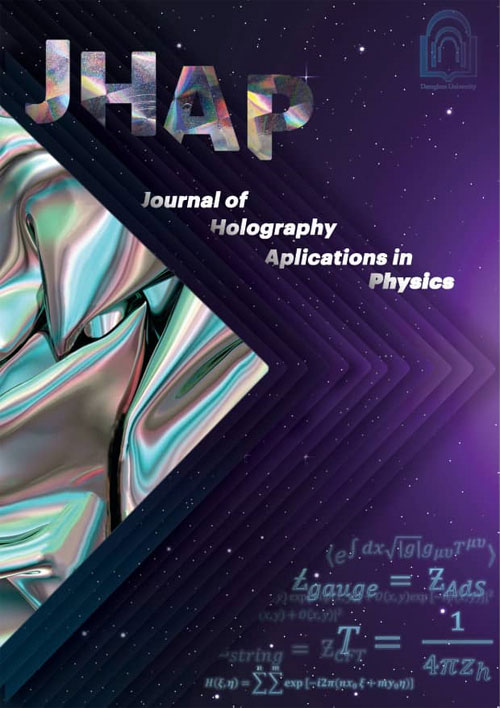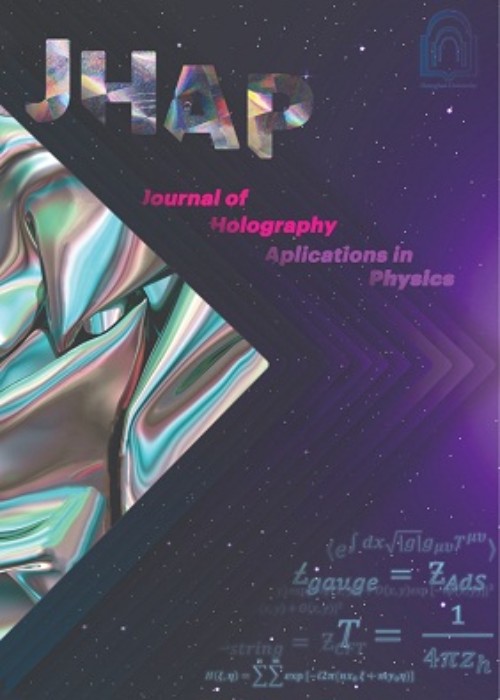فهرست مطالب

Journal of Holography Applications in Physics
Volume:1 Issue: 1, Autumn 2021
- تاریخ انتشار: 1400/08/10
- تعداد عناوین: 6
-
-
Pages 1-22Entanglement, chaos, and complexity are as important for de Sitter space as for AdS, and for black holes. There are similarities and also great differences between AdS and dS in how these concepts are manifested in the space-time geometry.In the first part of this paper the Ryu–Takayanagi prescription, the theory of fast-scrambling, and the holographic complexity correspondence are reformulated for de Sitter space. Criteria are proposed for a holographic model to describe de Sitter space. The criteria can be summarized by the requirement that scrambling and complexity growth must be ``hyperfast."In the later part of the paper I show that a certain limit of the SYK model satisfies the hyperfast criterion. This leads tothe radical conjecture that a limit of SYK is indeed a concrete, computable, holographic model of de Sitter space. Calculations are described which support the conjecture.Keywords: Holography, Entanglement, Complexity
-
Pages 23-36In 2006, Ryu and Takayanagi (RT) pointed out that (with a suitable cutoff) the entanglement entropy between two complementary regions of an equal-time surface of a d+1-dimensional conformal field theory on the conformal boundary of AdS{d+2} is, when the AdS radius is appropriately related to the parameters of the CFT, equal to 1/4G times the area of the $d$-dimensional minimal surface in the AdS bulk which has the junction of those complementary regions as its boundary, where $G$ is the bulk Newton constant. (More precisely, RT showed this for d=1 and adduced evidence that it also holds in many examples in d>1.) We point out here that the RT-equality implies that, in the quantum theory on the bulk AdS background which is related to the boundary CFT according to Rehren's 1999 algebraic holography theorem, the entanglement entropy between two complementary bulk Rehren wedges is equal to one 1/4G times the (suitably cut off) area of their shared ridge. (This follows because of the geometrical fact that, for complementary ball-shaped regions, the RT minimal surface is precisely the shared ridge of the complementary bulk Rehren wedges which correspond, under Rehren's bulk-wedge to boundary double-cone bijection, to the complementary boundary double-cones whose bases are the RT complementary balls.) This is consistent with the Bianchi-Meyers conjecture -- that, in a theory of quantum gravity, the entanglement entropy, S between the degrees of freedom of a given region with those of its complement takes the form S = A/4G (plus lower order terms) -- but only if the phrase `degrees of freedom' is replaced by `matter degrees of freedom'. It also supports related previous arguments of the author -- consistent with the author's `matter-gravity entanglement hypothesis' -- that the AdS/CFT correspondence is actually only a bijection between just the matter (i.e. non-gravity) sector operators of the bulk and the boundary CFT operators.Keywords: AdS, CFT, matter-gravity entanglement hypothesis, Bianchi-Myers conjecture
-
Pages 37-46We calculate by a new way the two point function on the boundary of AdS spacetime in 1+2 dimensions for the massless conformal real scalar field. The result agrees with the answer provided by the Boundary-limit Holography and Witten recipe. This is done in Poincar'{e} coordinates. The basic ingredients of this new method are conformal techniques, quantum fields defined on a half of Minkowski spacetime and a limit inspired by the Boundary-limit Holography. We also show that a state in AdS, the global vacuum, in three dimensions induces a state on the conformal boundary of AdS spacetime, which in turn induces a state on the BTZ black hole. On the other hand the same state in AdS induces a state on the BTZ black hole which in turn induces a state on its conformal boundary. The two ways of getting the state on the conformal boundary of the BTZ black hole coincide for the massless conformal real scalar field. We point out that the normalizable modes in the AdS/CFT correspondence for the BTZ black hole give a similar contribution as the non-normalizable modes used in the Witten prescription. We also give some clues on why the Witten and the Boundary-limit Holography prescription coincide.Keywords: QFT in Curved Spacetime, AdS, CFT, BTZ black hole, Holography
-
Pages 47-56In the three-dimensional anti-de Sitter spacetime/two-dimensional conformal field theory correspondence, we derive the imaginary-time path-integral of a non-relativistic particle in the anti-de Sitter bulk space, which is dual to the ground state, from the holographic principle.This derivation is based on(i) the author's previous argument that the holographic principle asserts that the anti-de Sitter bulk space as a holographic tensor network after classicalization has as many stochastic classicalized spin degrees of freedom as there are sites and(ii) the reinterpretation of the Euclidean action of a free particle as the action of classicalized spins.Keywords: Holographic Principle, Quantum Entanglement, Holographic Tensor Network, Classicalization
-
Pages 57-70The supercoherent states of the RNS string are constructed using the covariant quantization and analogously the light cone quantization formalisms. Keeping intact the original definition of coherent states of harmonic oscillators, we extend the bosonic annihalation operator into the superspace by inclusion of fermionic contribution to oscillator modes thus construct the supercoherent states with supersymetric harmonic oscillator. We analyse the statistics of these states by explicitly calculating the Mandel parameter and obtained interesting results about the nature of distribution of the statesKeywords: Coherent states, supercoherent states, Harmonic Oscillator, bosonic string, fermionic string
-
Pages 71-83This paper is devoted to investigate the thermodynamic stabilityof a generic cosmological fluid known as Van der Waals fluid inthe context of flat FRW universe. It is treated as a perfect fluidthat obeys the equation of state$P=frac{gammarho}{1-betarho}-alpharho^{2}, 0leqgamma<1$,where $rho$ stands for energy density and $P$ stands for pressureof the fluid. In this regard, we discuss the behavior of physicalparameters to analyze the evolution of the universe. Weinvestigate whether the cosmological scenario fulfills the thirdlaw of thermodynamics using specific heat formalism. Next wediscuss the thermal equation of state and by means of adiabatic,specific heat and isothermal conditions from classicalthermodynamics we examine the thermal stability.Keywords: Thermodynamics, gas, stability


